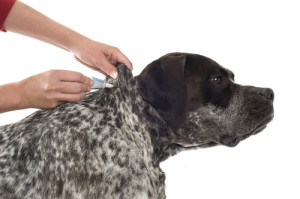As the weather turns cold, many of us forget about these pesky pests because we assume they die off. And they do, outside. But if you have a flea infestation in your home, the cold weather does not necessarily kill them off, since you keep your house warm.
Denise Petryk, DVM, Trupanion’s Director of Veterinary Services provided the following insight on flea management in winter.
Is it true fleas can be alive in a house in winter due to the warm temperature?
Absolutely, fleas their eggs, larva, pupa can all survive and hatch in the home and the cycle continues easily.
What temperature is “too cold” for fleas?
Freezing temperatures (32 degrees or below) are too cold for fleas if they are exposed to the cold for at least a week, but fleas often reside on animals—including our pets and wild animals—and their hosts’ regulated body temperatures create a nice warm home for the fleas even in winter.
How do you break a cycle of fleas?
In order to effectively break a cycle of fleas quickly, it’s important to kill fleas using more than one method and be consistent. Use a flea preventative for your pet and be sure to kill any fleas that get on them. Be sure to also hit the environment and repeat. See your veterinarian for specific advice tailored to your pet.

What is the best plan of attack for fleas in winter?
If you have a flea problem, your plan of attack will depend on where you live. Discuss the best year-round plan with your local veterinarian that knows your pet and that can provide customized advice for your area. The best plan in the winter might be the same even in the summer.
What products do you recommend?
Ask your veterinarian about Capstar to kill the fleas on your pet. Frontline, Revolution, or a similar preventative and Sentinel or a similar product can work well to prevent fleas. For the environment, boric acid or other premise sprays work well. Most importantly, talk to your veterinarian about what is best and safest for your pet and what is most suitable for your climate.
Final Thoughts
One of the common mistakes people make is thinking that because they no longer see fleas on their dogs, that they got rid of them. But, there may be eggs in their carpet, dog beds, furniture, etc., that will bring out a whole new infestation within a matter of weeks.
“The life cycle of the flea can take place in less than three weeks so consistency is essential,” says Dr. Petryk. “Repeat, repeat, repeat!”
For more facts about fleas, visit Trupanion’s blog.
About the Author
Based in Wilsonville, Ore., animal lover Kristina N. Lotz is a Certified Professional Dog Trainer – Knowledge Assessed (CPDT-KA) and works as a full time trainer. She is the founder of A Fairytail House, a unique all-positive all-sport dog training facility that helps rescue dogs in her area and provides free seminars and training classes for the community. In her spare time, she trains and competes in herding, agility, obedience, rally, and conformation with her Shetland Sheepdogs. She smartly married a Veterinary Technician, who helps keep the fur kids happy and healthy, and provides a quick resource for articles.
